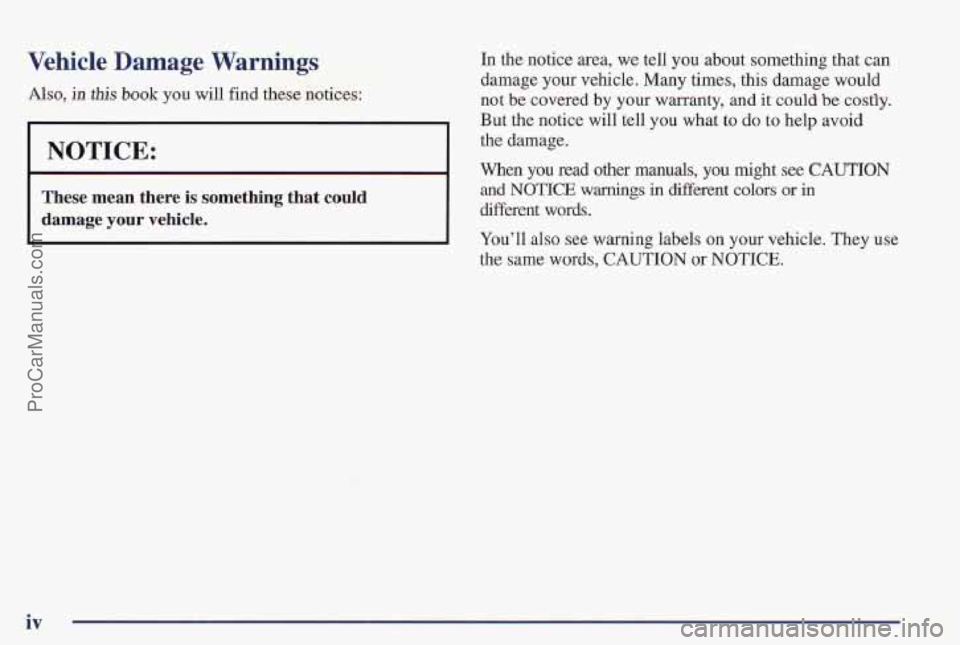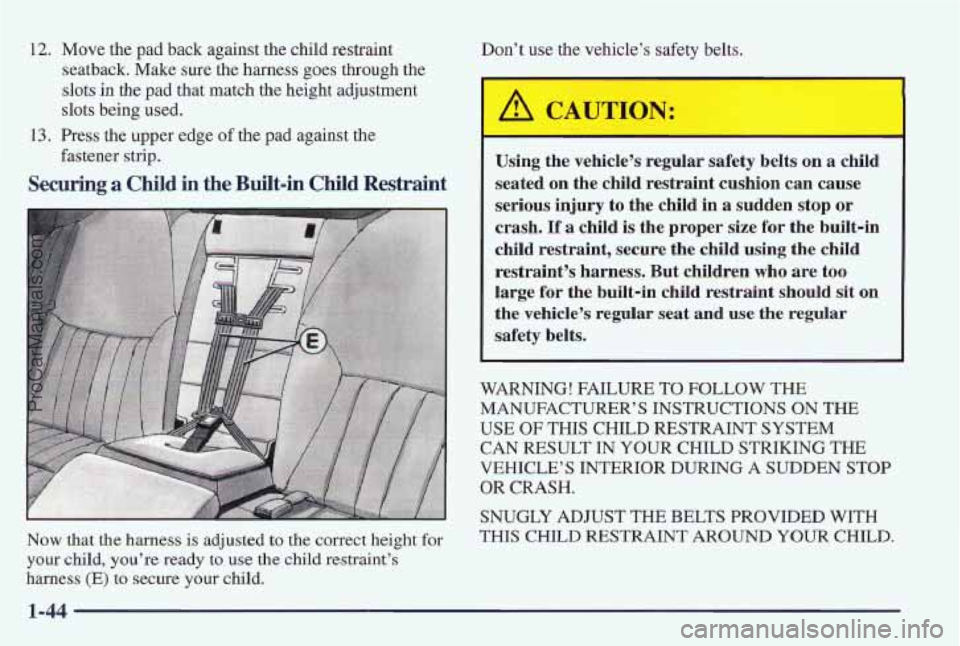1997 PONTIAC PONTIAC warning
[x] Cancel search: warningPage 5 of 419

How to Use this Manual
Many people read their owner’s manual from beginning
to end when they first receive their new vehicle.
If you
do this, it will help
you learn about the features and
controls for your vehicle. In this manual, you’ll find
that pictures and words work together to explain
things quickly.
Index
A good place to look for what you need is the Index in
the back of the manual. It’s an alphabetical list of all
that’s in the manual, and the page number where you’ll
find it.
Safety Warnings and Symbols
You will find a number of safety cautions in this book.
We use a box and the word CAUTION
to tell you
about things that could hurt you if you were to ignore
the warning.
1
I
These mean there is something that ( dd hurt
you or other people. I I I
In the caution area, we tell you what the hazard is. Then
we tell you what to do to help avoid or reduce the
hazard. Please read these cautions. If
you don’t, you or
others could be hurt.
k You will also find a circle
with a slash through
it in
this book. This safety
symbol means “Don’t,’’
“Don’t do this,” or “Don’t
let this happen.’’
iii
ProCarManuals.com
Page 6 of 419

Vehicle Damage Warnings In the notice area, we tell you about something that can
damage
your vehicle. Many times, this damage would
1, in this book you will find these notices: not be covered by your warranty, and it could be costly.
I I But the notice will tell you what to do to help avoid
A
I NOTICE:
I the damage.
-
When you read other manuals, you might see CAUTION
and NOTICE warnings in different collors or in
different words.
You’ll also see warning labels
on your vehicle. They use
the same words, CAUTION or NOTICE.
These mean there is something that could
damage your vehicle.
iv
ProCarManuals.com
Page 7 of 419

Vehicle Symbols
These are some of the symbols you may find on your vehicle.
For example,
these symbols are used on an
original battery:
POSSIBLE A
CAUTION
INJURY
PROTECT EYES BY
SHIELDING
CAUSTIC
BURNS AVOID
SPARKS
OR
FLAMES
SPARK OR ,\[I,
COULD FLAME
EXPLODE BATTERY
These symbols are important
for you and
your passengers
whenever your
vehicle is
driven:
n
FASTEN
SEAT
BELTS
q4
AIR BAG p
These symbols
have to do with
your lamps:
SIGNALS e
TURN
PARKING LAMPS
FOG LAMPS
$0
These symbols
are
on some of
your controls:
WINDSHIELD
WIPER
WINDSHIELD DEFROSTER
WINDOW
DEFOGGER
VENTILATING
~3
FAN
These symbols are used
on
warning and indicator lights:
COOLANT -
TEMP -
CHARGING BATTERY
SYSTEM
BRAKE
(0)
h
COOLANT
ENGINE OIL
w,
PRESSURE
ANTI-LOCK
(@)
BRAKES
Here are some
other symbols
you may see:
FUSE
P
LIGHTER m
HORN )cr
SPEAKER
b
FUEL la
V
ProCarManuals.com
Page 52 of 419

12. Move the pad back against the child restraint
seatback.
Make sure the harness goes through the
slots in the pad that match the height adjustment
slots being used.
fastener
strip.
13, Press the upper edge of the pad against the
Securing a Child in the Built-in Child Restraint
-
Now that the harness is adjusted to the correct height for
your child, you’re ready to use the child restraint’s
harness (E) to secure your child.
Don’t use the vehicle’s safety belts.
Using the vehicle’s regular safety belts on a child
seated on the child restraint cushion can cause
serious injury
to the child in a sudden stop or
cra,sh.
If a child is the proper size for the built-in
child restraint, secure the child using the child
restraint’s harness. But children
who are too
large for the built-in child restraint should sit on
the vehicle’s regular seat and use the regular
safety belts.
WARNING! FAILURE TO FOLLOW THE
MANUFACTURER’S INSTRUCTIONS ON THE
USE OF THIS CHILD RESTRAINT SYSTEM
CAN RESULT IN YOUR CHILD STRIKING
THE
VEHICLE’S INTERIOR DURING A SUDDEN STOP
OR CRASH.
SNUGLY ADJUST
THE BELTS PROVIDED WITH
THIS CHILD RESTRAINT AROUND YOUR CHILD.
ProCarManuals.com
Page 75 of 419

v Section 2 Features and Controls
Here you can learn about the many standard and optional features on your Pontiac, and information on starting,
shifting and braking. Also explained are the instrument panel and the warning systems that tell you if everything is
working properly
-- and what to do if you have a problem.
2-2
2-4
2-8
2- 10
2-12
2-15
2-15
2- 16
2-18
2-19
2-24
2-29
2-30
2-3 1
Important Information About Keys
Door Locks
Remote Keyless Entry Battery Replacement for RKE
Preventing Theft
of Your Vehicle
New Vehicle “Break-In”
Ignition Positions
Tips on Starting Your Engine
Using the Engine Coolant Heater
Automatic Transaxle Operation
Parking Brake Guidelines
Important Information on Engine Exhaust
Operation of Your Windows
Adjusting the Tilt Steering Wheel 2-32
2-33
2-33
2-35
2-3 8
2-39
2-40
2-5 3
2-54
2-62
2-64
2-78
2-83
Functions of the Multifunction Lever
How to Use the HighLow Beam
Headlamp Changer
Windshield Wipers and Fluid
Using Cruise Control
Exterior Lamps
Daytime Running Lamps
(DRL)
Interior Lamps
Rearview Mirrors
Storage Compartments
Instrument Panel Overview
All About Your Warning Lights and Gages
Driver Information Center
Head-Up Display
2-1
ProCarManuals.com
Page 90 of 419

OFF (C): This position lets you turn off the engine but
still
turn the steering wheel. It doesn’t lock the steering
wheel like LOCK. Use OFF if you must have your
vehicle
pushed or towed.
RUN (D): This position is where the key returns
after
you start your vehicle. With the engine off, you
can use RUN to display some of your warning and
indicator lights.
START (E): This position starts your engine.
A warning chime will sound if you open the driver’s
door when the ignition is in OFF, LOCK or
ACCESSORY and the key is in the ignition,
~
NOTICE:
~~
If your key seems stuck in LOCK and you can’t
turn it, be sure your are using the correct key; if
so is it all the way in? If it is, then turn the
steering wheel left and right while yon turn the
key hard.
But turn the key only with your hand.
Using
a tool to force it could break the key or the
ignition
switch. If none of this works, then your
vehicle needs service.
Starting Your Engine
Move your shift lever to PARK (P) or NEUTRAL (N).
Your engine won’t start in any other position -- that’s a
safety feature. To restart when you’re already moving,
use NEUTRAL
(N) only.
NOTICE:
Don’t try to shift to PARK (P) if your Pontiac is
moving. If you do, you could, damage the
transaxle. Shift to
PARK (P) only when your
vehicle
is stopped.
1. Without pushing the accelerator pedal, turn your
ignition key to
START. When the engine starts, let
go of the key. The idle speed will go down as your
engine gets warm.
2-16
ProCarManuals.com
Page 138 of 419

Warning Lights, Gages and Indicators
This part describes the warning lights and gages that
may be on your vehicle. The pictures will help
you
locate them.
Warning lights and gages can signal that something is
wrong before
it becomes serious enough to cause an
expensive repair or replacement. Paying attention to
your warning lights and gages could also save
you or
others from injury.
Warning lights come on when there may be or is a
problem with one of your vehicle’s functions. As you
will see in the details on the next few pages, some
warning lights come on briefly when
you start the
engine
just to let you know they’re working. If you are
familiar with this section,
you should not be alarmed
when this happens.
Gages can indicate when there may
be or is a problem
with one of your vehicle’s functions. Often gages and
warning lights work together to let
you know when
there’s a problem with your vehicle.
When one of the warning lights comes on and stays on
when you are driving, or when one of the gages shows
there may be
a problem, check the section that tells you what
to do about it. Please follow this
manual’s advice.
Waiting
to do repairs can be costly -- and even
dangerous.
So please get to know your warning lights
and gages. They’re a big help.
Your vehicle may also have a driver information system
that works along with the warning lights and gages. See
“Driver Information System” in the Index.
Safety Belt Reminder Light
When the key is turned to RUN or START, a chime will
come on for about eight seconds to remind people
to
fasten their safety belts, unless the driver’s safety belt is
already buckled.
The safety belt light will
also come on and stav
on .I
for about 20 seconds, then
it will flash for about
55 seconds. If the driver’s
belt
is already buckled,
neither the chime nor
the
light will come on.
2-64
ProCarManuals.com
Page 140 of 419

Charging System Light
/+I
The charging system light
will come on briefly when
you turn on the ignition,
as
a check to show you
it’s working. Then it will
go out.
If it stays on, or comes on while you are driving, you
may have a problem with the charging system. It could
indicate that
you have a loose drive belt or another
electrical problem.
Have it checked right away. Driving
while this light
is on could drain your battery.
If you must drive a short distance with the light on, be
certain to turn
off all your accessories, such as the radio
and air conditioner.
Brake System Warning Light
Your Pontiac’s hydraulic brake system is divided into
two parts.
If one part isn’t worhng, the other part can
still work and stop you. For good braking, though, you
need both parts working well.
If the warning light comes on, there could be a brake
problem. Have your brake system inspected right away.
This light should come on
briefly when
you turn the
BRAKE I
ignition key to RUN. If it
doesn’t
come on then, have
(0 (7)
:;:;gu if there’s
it fixed so it will be ready
If the light comes on while you are driving, pull off the
road and stop carefully. You may notice thatthe pedal is
harder to gush. Or, the pedal may go closer to the floor.
It may take longer to stop. If the light is still on, or if the
ProCarManuals.com